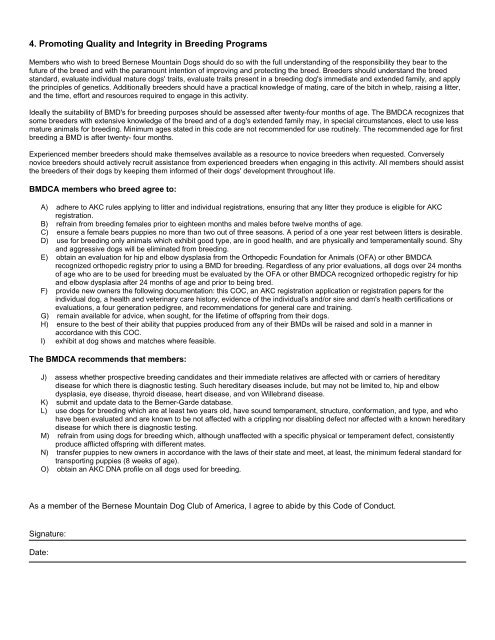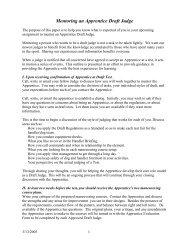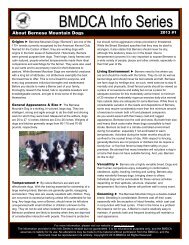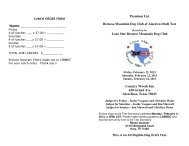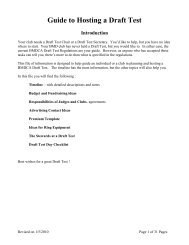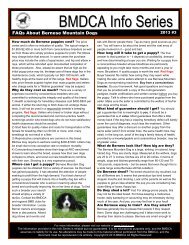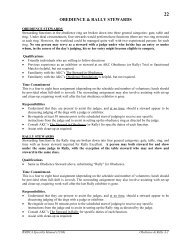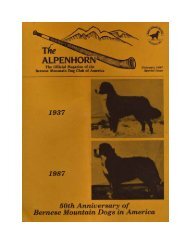COC - PDF - Bernese Mountain Dog Club of America
COC - PDF - Bernese Mountain Dog Club of America
COC - PDF - Bernese Mountain Dog Club of America
Create successful ePaper yourself
Turn your PDF publications into a flip-book with our unique Google optimized e-Paper software.
4. Promoting Quality and Integrity in Breeding ProgramsMembers who wish to breed <strong>Bernese</strong> <strong>Mountain</strong> <strong>Dog</strong>s should do so with the full understanding <strong>of</strong> the responsibility they bear to thefuture <strong>of</strong> the breed and with the paramount intention <strong>of</strong> improving and protecting the breed. Breeders should understand the breedstandard, evaluate individual mature dogs' traits, evaluate traits present in a breeding dog's immediate and extended family, and applythe principles <strong>of</strong> genetics. Additionally breeders should have a practical knowledge <strong>of</strong> mating, care <strong>of</strong> the bitch in whelp, raising a litter,and the time, effort and resources required to engage in this activity.Ideally the suitability <strong>of</strong> BMD's for breeding purposes should be assessed after twenty-four months <strong>of</strong> age. The BMDCA recognizes thatsome breeders with extensive knowledge <strong>of</strong> the breed and <strong>of</strong> a dog's extended family may, in special circumstances, elect to use lessmature animals for breeding. Minimum ages stated in this code are not recommended for use routinely. The recommended age for firstbreeding a BMD is after twenty- four months.Experienced member breeders should make themselves available as a resource to novice breeders when requested. Converselynovice breeders should actively recruit assistance from experienced breeders when engaging in this activity. All members should assistthe breeders <strong>of</strong> their dogs by keeping them informed <strong>of</strong> their dogs' development throughout life.BMDCA members who breed agree to:A) adhere to AKC rules applying to litter and individual registrations, ensuring that any litter they produce is eligible for AKCregistration.B) refrain from breeding females prior to eighteen months and males before twelve months <strong>of</strong> age.C) ensure a female bears puppies no more than two out <strong>of</strong> three seasons. A period <strong>of</strong> a one year rest between litters is desirable.D) use for breeding only animals which exhibit good type, are in good health, and are physically and temperamentally sound. Shyand aggressive dogs will be eliminated from breeding.E) obtain an evaluation for hip and elbow dysplasia from the Orthopedic Foundation for Animals (OFA) or other BMDCArecognized orthopedic registry prior to using a BMD for breeding. Regardless <strong>of</strong> any prior evaluations, all dogs over 24 months<strong>of</strong> age who are to be used for breeding must be evaluated by the OFA or other BMDCA recognized orthopedic registry for hipand elbow dysplasia after 24 months <strong>of</strong> age and prior to being bred.F) provide new owners the following documentation: this <strong>COC</strong>, an AKC registration application or registration papers for theindividual dog, a health and veterinary care history, evidence <strong>of</strong> the individual's and/or sire and dam's health certifications orevaluations, a four generation pedigree, and recommendations for general care and training.G) remain available for advice, when sought, for the lifetime <strong>of</strong> <strong>of</strong>fspring from their dogs.H) ensure to the best <strong>of</strong> their ability that puppies produced from any <strong>of</strong> their BMDs will be raised and sold in a manner inaccordance with this <strong>COC</strong>.I) exhibit at dog shows and matches where feasible.The BMDCA recommends that members:J) assess whether prospective breeding candidates and their immediate relatives are affected with or carriers <strong>of</strong> hereditarydisease for which there is diagnostic testing. Such hereditary diseases include, but may not be limited to, hip and elbowdysplasia, eye disease, thyroid disease, heart disease, and von Willebrand disease.K) submit and update data to the Berner-Garde database.L) use dogs for breeding which are at least two years old, have sound temperament, structure, conformation, and type, and whohave been evaluated and are known to be not affected with a crippling nor disabling defect nor affected with a known hereditarydisease for which there is diagnostic testing.M) refrain from using dogs for breeding which, although unaffected with a specific physical or temperament defect, consistentlyproduce afflicted <strong>of</strong>fspring with different mates.N) transfer puppies to new owners in accordance with the laws <strong>of</strong> their state and meet, at least, the minimum federal standard fortransporting puppies (8 weeks <strong>of</strong> age).O) obtain an AKC DNA pr<strong>of</strong>ile on all dogs used for breeding.As a member <strong>of</strong> the <strong>Bernese</strong> <strong>Mountain</strong> <strong>Dog</strong> <strong>Club</strong> <strong>of</strong> <strong>America</strong>, I agree to abide by this Code <strong>of</strong> Conduct.Signature:Date:


